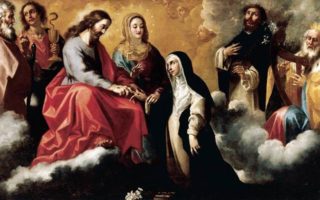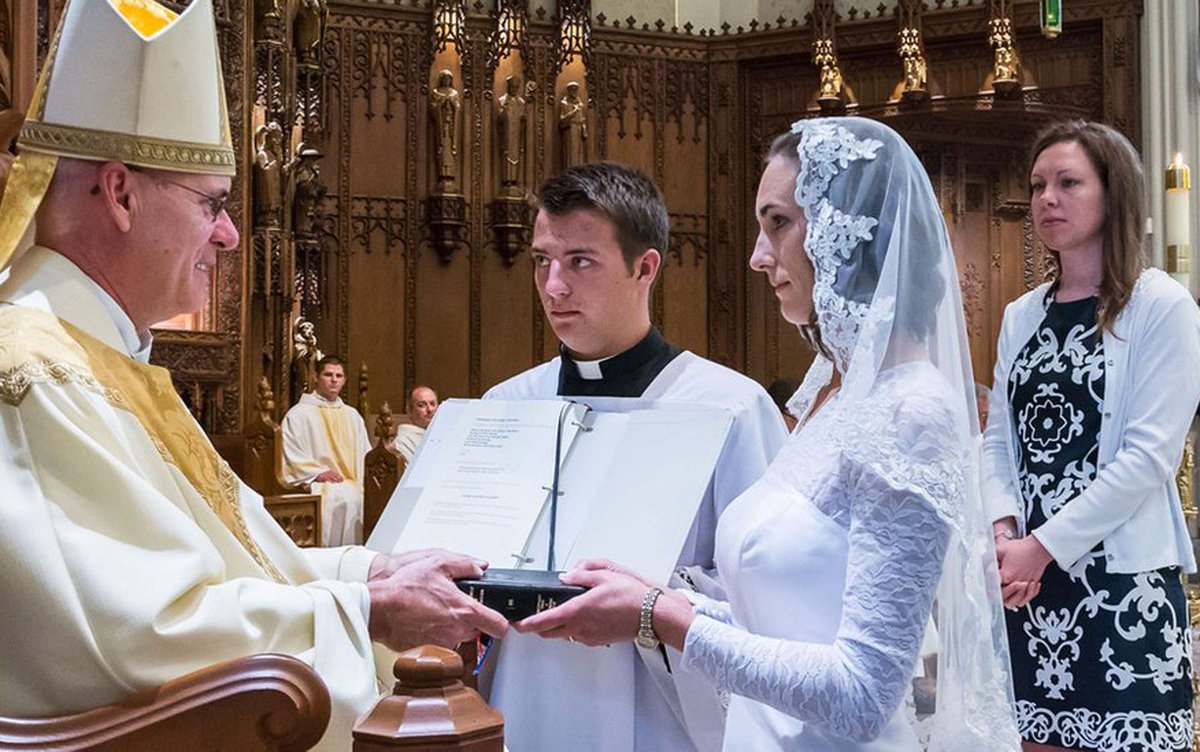Last time I shared about some of the problems with Jesus is my boyfriend types of songs. As I mentioned then, the theology behind those songs has been around much longer than you might think.
The origins of Bridal Theology
Bridal Theology, also called Bridal Mysticism, can be traced back to the mystics in the Middle Ages. At that time there was an important shift from the biblical teaching that the church is the bride of Christ to the idea that we are individually brides of Christ.
One of the earliest proponents of bridal theology was Bernard of Clairvaux (1090-1153). He wrote a collection of 86 sermons on the Song of Solomon, which was his most famous work. After his death other monks added 167 more sermons. That’s 253 sermons on 8 chapters! Obviously Song of Solomon was very important to them. At times he referred to himself as “a woman” and advised his monks to be “mothers” and to “let your bosoms expand with milk, not swell with passion” (Leon Podles, The Church Impotent, p. 104).
Clare of Assisi (1194-1253) used romantic and erotic language to describe her relationship with God:
Draw me on!
We will run after you in the perfume of your ointment, heavenly spouse.
Let me run and not faint until you lead me into your wine cellar;
your left hand rests under my head, your right arm joyfully embraces me,
and you kiss me with the sweet kiss of your lips.
I wonder if 13th century lovers went to the wine cellar to make out.
 Catherine of Siena (1347-1380) was well known for her “mystic marriage” to Jesus (see picture). Others who embraced this theology include Teresa of Ávila (1515 to 1582) and John of the Cross (1542-1591).
Catherine of Siena (1347-1380) was well known for her “mystic marriage” to Jesus (see picture). Others who embraced this theology include Teresa of Ávila (1515 to 1582) and John of the Cross (1542-1591).
The Catholic Encyclopedia explanations the theology of mystic marriage as something reserved for a select few. But the idea has been applied much more widely.
Marriage to Jesus
 Traditionally, many Roman Catholic nuns considered themselves married to Jesus. Sometimes they hold a wedding ceremony and received ring. In reading various Catholic sites on the web, I found that some nuns today believe that they are married to Jesus while others do not.
Traditionally, many Roman Catholic nuns considered themselves married to Jesus. Sometimes they hold a wedding ceremony and received ring. In reading various Catholic sites on the web, I found that some nuns today believe that they are married to Jesus while others do not.
 A few years ago there was a news story about a Roman Catholic woman who committed herself to be a “consecrated virgin,” which includes some of the commitments of a nun but does not require living in a convent. Her consecration ceremony looked remarkably like a wedding.
A few years ago there was a news story about a Roman Catholic woman who committed herself to be a “consecrated virgin,” which includes some of the commitments of a nun but does not require living in a convent. Her consecration ceremony looked remarkably like a wedding.
While this may seem bizarre to Protestants, some conservative churches have urged single young women to consider Jesus as their boyfriend until they find the right guy to marry. Sometimes they receive purity rings in a ceremony and attend purity ball wearing a dress that resembles a wedding dress. The Bible teaches that all single people should practice abstinence until marriage, but it is strange to make that pledge in a setting that resembles a wedding.
Song of Solomon
In the Middle Ages, the Song of Solomon played a major role in the development of the theology of mystic marriage. If the Bible itself uses romantic and erotic language to describe our relationship with God, why shouldn’t we use it as well?
Historically there have been two primary ways of interpreting the Song of Solomon
- As a text about the love and sexual intimacy of human beings (literal interpretation)
- As a text that uses the language of love and intimacy to speak about God’s relationship with his people (allegorical interpretation)
In the first five centuries AD both approaches were used. The council of Constantinople in AD 550 outlawed the literal reading, establishing the allegorical interpretation as the only correct interpretation. Many people felt that it was inappropriate to see a book of Holy Scripture as celebrating romantic and sexual love between a man and a woman. There was a lot of pressure to find a more “spiritual” meaning.
During the Middle Ages there was a shift by some of the mystics from seeing the Song of Solomon as describing God’s relationship with his people as a whole to an individual interpretation. This opened the way to the use of bridal imagery to describe the personal experience of the mystics. Perhaps not surprisingly, many of those mystics were women. Then, as now, most men find it difficult to see themselves as anyone’s “bride.” That is one reason many men are uncomfortable in church.
Song of Solomon includes some fairly explicit passages (e.g. Song of Sol. 1:2-3, 12-13; 6:2-3) as well of several richly symbolic descriptions in which the couple expresses their admiration for each other. It takes some real exegetical gymnastics to make all these passages have a “spiritual” meaning.
Since the Reformation the literal interpretation has again been embraced by many. Most of the conservative biblical commentaries that I have seen take the “literal” approach to interpretation.
The Role of Scripture
There is much of value that we can learn from ancient theologians, including the mystics. But they were flawed human beings, as we are. There are some things we might not want to copy. Bernard of Clairvaux was an enthusiastic supporter of the Crusades. Some of the mystics had serious health problems and died an early death due to extreme fasting and self-deprivation. Teresa of Ávila promoted weekly self-flagellation.
Only the Bible is the uniquely inspired Word of God. All other sources must be evaluated on the basis of the teaching of Scripture. That includes evaluating our interpretation of one part of Scripture (e.g. Song of Solomon) on the basis of the rest of Scripture. There are many passages in both the OT and the NT where the image of marriage is used to depict certain aspects of God’s relationship with his people as a whole. But it is difficult to find any cases in which such imagery is used to describe our individual relationship to God.

Well, that’s a bummer, I just googled bridal mysticism based on a mention of it in the Everyday Mysticism series of lectures I found at my library by Fr. Ciorra. I was hoping the idea was rooted in getting closer to grace through one’s actual marriage and the grace one sees and finds there. I mean, I’ll be the first to admit that I’m no saint but I do believe I’m light years ahead of who I was before I met my wife.
Thanks for sharing your thoughts. God often works through human relationships, and those of us who are married have learned many spiritual lessons through our relationship with our spouse. Unfortunately bridal mysticism is something very different.